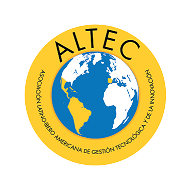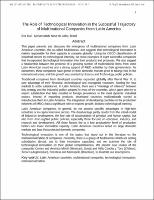| dc.description.abstract | This paper presents and discusses the emergence of multinational companies from Latin American countries, the so-called Multilatinas, and suggests that technological innovation is mainly responsible for their capacity to compete globally. Using the OECD classification of industrial sectors by technological intensity, we show examples of eight successful companies that incorporated technological innovation into their products and processes. We also suggest a relationship between the presence of a growing number of multinational firms from some Latin American countries and a strong support of R&D activities by their governments. As latecomers, these companies have grown in their domestic markets prior to taking risks in the international arena, and this growth was assisted by Science and Technology public policies. Traditional companies from developed countries expanded globally after World War II, to take advantage of their financial, technological and managerial resources, looking for new markets to settle subsidiaries. In Latin America, there was a “marriage of interests” between this strategy and the industrial policy adopted in most of the countries, which gave priority to import substitution that later resulted in foreign prevalence in the most dynamic industrial sectors. Instead of exporting products, developed countries multinationals started to manufacture them in Latin America. The integration of developing countries in the production networks of MNCs had a significant role on exports growth, besides technological learning. Latin American companies, in general, do not possess specific advantages in high-tech industries or in capital intensive sectors. The disadvantage partly results from the initial model of industrial development, the low rate of accumulation of physical and human capital, but also from short-sighted public policies, especially those focused on education, industry, and research and development. All these factors led to a low productivity level of production factors and lower innovation capacity. Latin American countries relied on large domestic markets and laws that protected domestic companies. Technological innovation is one of the topics that stand out in the literature on the internationalization of companies. Presently, there is a group of Multilatinas which are setting subsidiaries abroad, due to their innovative capacities, and we examine the role of technological innovation on their global competitiveness. We present case studies of the companies Cemex and América Móvil (Mexican), Sonda and Viña Concha y Toro (Chilean), Tenaris (Argentinean), Petrobras and Marcopolo (Brazilian), to illustrate our assumptions. | |


